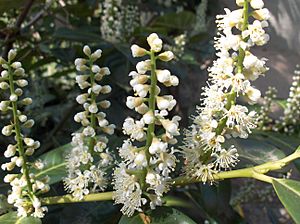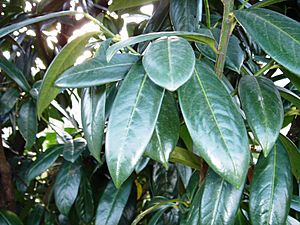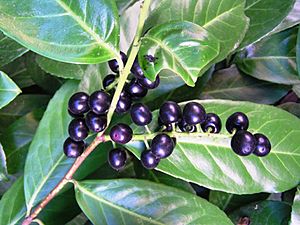Cherry laurel facts for kids
Quick facts for kids Cherry laurel |
|
|---|---|
 |
|
| Foliage and flowers | |
| Conservation status | |
| Scientific classification | |
| Synonyms | |
|
List
|
The Prunus laurocerasus, often called cherry laurel or common laurel, is an evergreen plant. In North America, it's sometimes known as English laurel. This plant is a type of cherry tree (Prunus). It originally comes from areas around the Black Sea. You can find it from Albania and Bulgaria in Europe, all the way east through Turkey to the Caucasus Mountains and northern Iran.
The name "cherry laurel" comes from how its leaves look like those of the bay laurel (Laurus nobilis). Both plants were used to make laurel wreaths. However, they are not closely related. Don't confuse it with its American cousin, Prunus caroliniana, which is also called cherry laurel.
Contents
What Cherry Laurel Looks Like
Cherry laurel is an evergreen shrub or a small to medium-sized tree. It can grow 5 to 15 meters tall, and sometimes even taller. Its trunk can be up to 60 cm wide.
Its leaves are dark green, shiny, and feel a bit like leather. They are usually 10 to 25 cm long and have small teeth along their edges. If you crush the leaves, they might smell like almonds.
The flower buds appear in early spring. They open in early summer into upright clusters called racemes. These clusters are 7 to 15 cm long and hold 30 to 40 flowers. Each flower is about 1 cm wide, with five creamy-white petals. They also have many yellowish parts called stamens and a sweet smell.
The fruit is a small cherry, about 1 to 2 cm wide. It turns black when it ripens in early autumn.
Growing Cherry Laurel
Cherry laurel is a very popular ornamental plant. People plant it in gardens and parks all over the world, especially in places with mild climates. It is often used to create hedges or as a screen to block views.
Most types of cherry laurel are strong shrubs. They can grow well even in tough spots, like shady or dry areas. They also respond well to being trimmed, which is called pruning.
Popular Types of Cherry Laurel
More than 40 different types, or cultivars, of cherry laurel have been chosen for their special features. Some of these include:
- 'Aureovariegata': This type has leaves with yellow edges.
- 'Magnifolia': This one grows very fast and has large leaves, up to 30 cm long.
- 'Otto Luyken': Named after Otto Luyken, this type is a half-dwarf. It has smaller leaves, about 10 cm long.
- 'Schipkaensis'
- 'Zabeliana': This type was chosen because it can handle cold winters better.
The 'Otto Luyken' type has won an award called the Royal Horticultural Society's Award of Garden Merit.
Where It Grows Naturally
This plant is found in woods and bushy areas. It has spread widely in some places, like Northern Ireland, where it grows wild after escaping from gardens.
In Turkey's Eastern Black Sea Region, especially around Trabzon and Giresun, some types of cherry laurel are considered native plants.
Cherry Laurel as an Invasive Plant
In some areas, like the United Kingdom and the Pacific Northwest of North America, cherry laurel can become an invasive plant. This means it can spread quickly and take over.
Because it grows fast, stays green all year, and can handle dry or shady conditions, it often out-competes and harms native plant species. Birds help spread its seeds through their droppings.
Other Uses for Cherry Laurel
The leaves of the cherry laurel are also used in flower arrangements.
The fruits of the cherry laurel are edible, but they can taste a bit bitter. They contain small amounts of a substance called hydrogen cyanide. If a fruit tastes very bitter, it means it has more of this substance, so it should not be eaten. The seed inside the fruit, and the leaves, have higher amounts of hydrogen cyanide and should never be eaten. The seeds are poisonous, similar to the seeds found inside apricots and peaches.
Is Cherry Laurel Poisonous?
Yes, the leaves and seeds of the cherry laurel can cause serious problems if a human eats them. The seeds inside the cherries are poisonous, just like the rest of the plant. They contain chemicals called cyanogenic glycosides and amygdalin. These chemicals are what give the leaves their almond-like smell when crushed.
A liquid called Laurel water, which is made from the plant, contains prussic acid (which is hydrogen cyanide) and other compounds. This liquid is also toxic.
Cherry Laurel Wood
The wood of the cherry laurel contains a lot of water. When you cut it, it can make blades sticky. It also tends to crack and change shape when it dries.
Freshly cut wood is a creamy white color and smells like almonds. When it dries, it turns orange and brown. Larger pieces of the wood can be used for turning into bowls.
Similar Plants
Prunus lusitanica, also known as Portuguese laurel, looks similar to cherry laurel. However, you can tell them apart by its sharply toothed leaves and red leaf stems.
See also
 In Spanish: Prunus laurocerasus para niños
In Spanish: Prunus laurocerasus para niños





